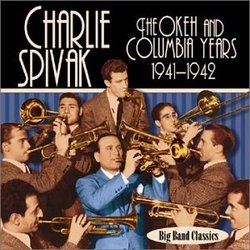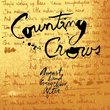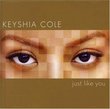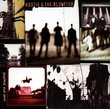| All Artists: Charlie Spivak Title: Okeh & Columbia Years 1941-42 Members Wishing: 1 Total Copies: 0 Label: Collectables Release Date: 5/7/2002 Genres: Jazz, Pop Style: Swing Jazz Number of Discs: 1 SwapaCD Credits: 1 UPC: 090431667521 |
Search - Charlie Spivak :: Okeh & Columbia Years 1941-42
 | Charlie Spivak Okeh & Columbia Years 1941-42 Genres: Jazz, Pop
|
Larger Image |
CD DetailsSimilar CDsSimilarly Requested CDs
|
CD ReviewsWhy Not Volume 2 Covering His Victor/RCA Victor Years? 08/10/2007 (5 out of 5 stars) "There is a good variety of Charlie Spivak big band music available, but none of them go far enough into his recording career to capture the hits he had with Victor/RCA Victor from 1944 to 1948 [and his last which came in 1950 for the London label]. Charlie, born on February 17, 1906 and raised in New Haven, Connecticut, was a trumpet player who, in spite of having honed his talents while in the employ of bands of varying styles, some of them noted jazz legends, went more in the direction of the sweet sound of Guy Lombardo after he formed his own orchestra in 1939 with the financial assistance of his good friend, Glenn Miller. He first worked in the band of Don Cavallaro, then, from 1924 to 1930, found steady employment with Paul Specht and his Orchestra. From 1931 to 1934 he was a member of the Ben Pollack band before moving over to the Dorsey Brothers and then Ray Noble in 1934/35. Following studio work in 1936/37 he hooked up with the likes of Bob Crosby, Tommy Dorsey after he split with brother Jimmy, and Jack Teagarden. After forming his own band, and suffering a bit of a wonky start, he secured a contract with Columbia which, at first, decided to release his singles on their Okeh subsidiary, with the first hit being Intermezzo (A Love Story) from the Ingrid Bergman film. In August 1941 the instrumental reached # 10, followed a few months later by another instrumental, Let's Go Home, which peaked at # 19 and became his theme song. Early in January 1942, with the addition of vocalist Garry Stevens and a group calling themselves The Stardusters, he had This Is No Laughing Matter hit the # 8 slot, at which point Columbia made the decision to switch him to their main label. That September he had a double-sided hit when My Devotion became his best hit ever, reaching # 2, b/w I Left My Heart At The Stage Door Canteen [# 8], with Stevens doing the vocals on both. The success of this record also brought an earlier release back into play at much the same time, with Brother Bill going to # 20 with vocal by The Stardusters. Late in 1942 his version of White Christmas, again with Stevens on vocal, finished at # 18 which put him well back of the Crosby entry [# 1] for Decca, but did all right against those of Gordon Jenkins on Capitol [# 16] and Freddy Martin on Victor [# 20]. But that was it for his Columbia hits, all of which - except for White Christmas - are in this tidy little package from Collectables, complete with excellent sound reproduction and interesting notes. What we need now is for a volume containing his next 12 hits registered from 1944 to 1950. His first for Victor came in late 1944/early 1945 when both sides of a release charted - Too-Ra-Loo-Ra-Loo-Ral (That's An Irish Lullaby) going to # 12 as an instrumental, and Let Me Love You Tonight reaching # 23 with Jimmy Saunders doing the vocal. In late April 1945 new female vocalist Irene Daye had a # 16 with (I Love You, I Love You, I Love You) Sweetheart Of All My Dreams [earlier, while singing with the Gene Krupa band, Daye had done the vocals on his 1941 hit There'll Be Some Changes Made, and later would become Spivak's wife]. One month later Saunders was back doing both sides of the next release which had You Belong To My Heart go to # 6 and There Must Be A Way reach # 9. Then Daye took over for Can't You Read Between The Lines [# 16 in July] and It's Been A Long, Long Time [# 4 in November, followed by Saunders again early in 1946. Now on the RCA Victor label, Oh! What It Seemed To Be peaked at # 5 in April, and (I Love You) For Sentimental Reasons made the same position in late December 1946/January 1947. When his version of Linda hit the charts in early 1947 the vocalist was Tommy Mercer and it too made it to the # 5 spot. Then came a drought until March 1948 when Now Is The Hour [Maori Farewell Song] topped out at # 14, again with Mercer on vocals. Two years later he would have his final hit when Mona Lisa reached # 16 in August 1950 with Tommy Lynn and a choir doing the vocals. Spivak, however, would remain active almost right up to the time of his death on March 1, 1982 at age 75, cutting his last sides in 1981. One of the unsung big bands of that era, his hits deserve a decent "definitive" compilation, but until then this is a good place to sample his work." A standard-issue 1940's dance orchestra C. Craig | Havant, England, UK | 01/31/2006 (3 out of 5 stars) "Charlie Spivak is the quintessential dance band sound of the 1940s - commercial, professional, but lacking any identity and style other than good musicianship. There is nothing wrong with the band, it just lacks emotion, and Spivak's strangled muted trumpet style takes you nowhere. Despite this, it was a highly successful second league outfit, and lasted well into the late 40's - which is more than can be said for many top-flight name bands! The sound is rather boxed-in, and a lot of the original dynamics may have been lost, which is a shame. An interesting CD to listen to now and then, but it echoes George T Simon's comment that this was a band that never "let go" in its performances. When Spivak plays an open trumpet - like on 'Serenade in Blue' the band sounds so much better." Okeh, but no more than that. JJA Kiefte | Tegelen, Nederland | 01/16/2009 (3 out of 5 stars) "This collection of Charlie Spivak's hits for Okeh and Columbia is typical for many of the forties' big bands. While the musicianship may be impeccable (with men like Bunny Shawker and Dave Tough on drums, Nelson Riddle on trombone and as arranger, Les Elgart on trumpet and June Hutton as vocalist, how could it not be?) the emphasis on run of the mill material with 'hit' potential makes the endless stream of recordings redundant and even tedious, the arrangements not being able to add enough variety to keep things interesting. The unfortunate muting of Spivak's glorious open horn notwithstanding his band was successful enough, scoring some minor hits well into the late forties. Remastering may not be ideal, but certainly not unlistenable (the Hep release which overlaps with only two items is better in this respect). Although this cd gives us a good picture of what generally big bands sounded like in the early to mid forties, it is not a very essential addition to ones discography."
|

 Track Listings (24) - Disc #1
Track Listings (24) - Disc #1











